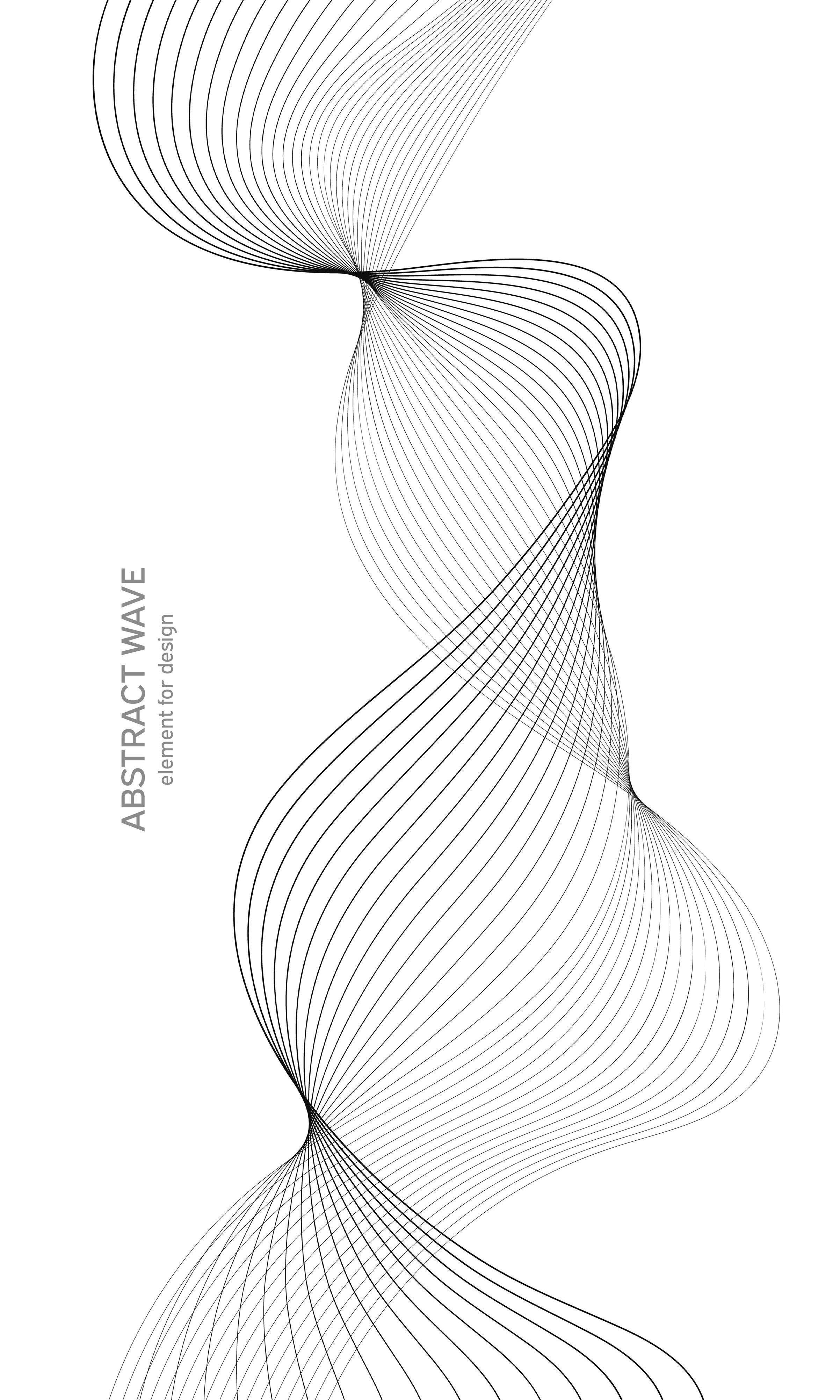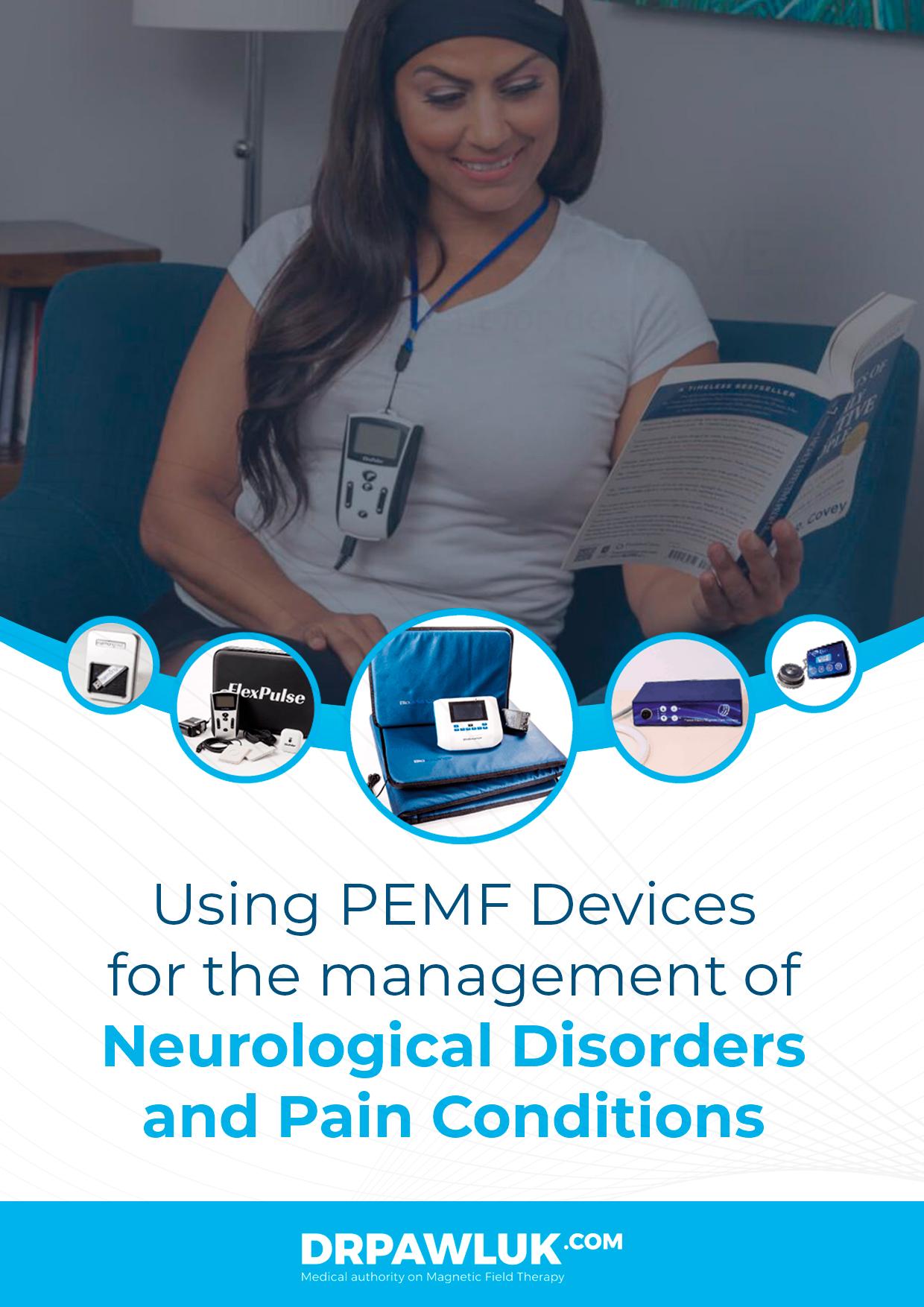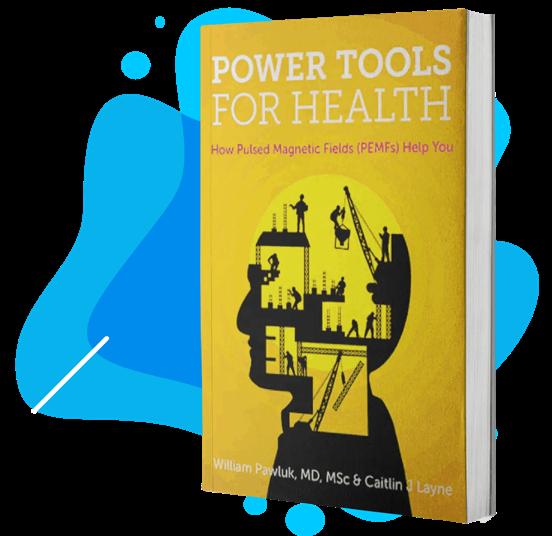Effectively Treat Neurological Disorders and Pain Conditions with PEMF Devices
Conventional treatments for difficult-to-manage neurological and pain disorders can be both costly and ineffective. Pulsed electromagnetic fields (PEMF) are an emerging innovative approach to managing these disorders to get to the root cause of a condition, allowing for more effective - and less costly - treatment. There are a wide range of PEMF devices designed for home use and available for purchase by consumers with proper assessment, guidance and follow-up by qualified clinicians.
PEMF therapy is a safe, non-invasive treatment for numerous conditions. It has been shown to support progress in neuro-chemical conditions that include addiction, ADHD, anxiety, autism spectrum disorders, depression, PTSD, and sleep issues. Research also indicates benefits in neuro-pathologies such as concussion, memory loss, mild cognitive impairment (MCI), mild traumatic brain injury (TBI), multiple sclerosis, Parkinson’s disease, stroke, and tremor, among others.
A number of PEMF devices are FDA approved. These include high-powered rTMS (repetitive transcranial magnetic stimulation) devices used in hospitals, for treatment resistant major depressive disorders (MDD). Other PEMF devices are approved for bone healing and wound healing.
Impacts of PEMFs on the Body
As a magnetic field passes through the body, that field can stimulate a range of physical processes and activities, depending on the frequency and power. Research studies conducted since the 1980s have demonstrated a wide range of impacts, including the following:
■ Reducing inflammation and edema (Jerabek & Pawluk, 1996)
■ Increasing ATP production (Ascherl, Blumel, Lechner, et al., 1985; Blank & Soo, 1992; Chen, Cui, Yue, et al, 2009)
■ Rebalancing circadian rhythm (Manzella, Bracci, Ciarapica, et al., 2015)
■ Improving circulation and blood supply (Bartko, Turcáni, Danisová, et al., 1988)
■ Increased oxygen to the body’s tissues (Warnke, 1992; Grant, Cadossi, & Steinberg, 1994)
■ Healthy levels of growth factors and nitric oxide (Goodwin, 2003)

■ Increasing cell metabolism (Jerabek et al, 1996)
■ Production of endogenous antioxidants (Singh, Khanduja, & Mittal, 1998)
■ Enhanced detoxification (Singh & Khanduja, 1998)
■ Wound healing and tissue regeneration (Blackman, 1988; Blank & Soo, 1992)
■ Stimulating and rebalancing the immune system (McEver & Zhu, 2010)
■ Improved nerve conductivity and regeneration (Polk, 1992)
■ Promotion of growth gene factors (Goodwin, 2003; Lagrove, Bersani, Billaudel, et al., 2003)
■ Support of neural stem cell production (Li, Zhao, Xing, et al., 2002; Goodwin, 2003)
■ Reduced pain (Nelson & Esty, 2009, 2015)
■ Autophagy (Marchesi, Osera, Fassina, et al., 2014)
■ Enhanced neurotransmitter levels (Zecca, Margonato, & Esposti, 1989)
■ Effect on monoamine function (Sieron, Labus, & Nowak, 2004)
■ Reduced reaction time (Blackman, 1988)
■ Charge displacement from neuronal membranes of cortical neurons (Persinger & Saroka, 2013)
■ Reducing inflammation (Borea, 2016; Massari, 2007; Varani, 2017)
■ Stimulating the endocannabinoid system (Li, 2017)
How Do PEMFs Aid in Healing?
Simply put, PEMFs promote healing at the cellular level. Healthy cells have natural positive and negative charges that are required for the proper exchange of potassium, sodium and calcium ions. When cells are damaged, they can’t function properly. Pulsed electromagnetic fields balance the charges, allowing for normal functioning and tissue repair. All of your body’s tissues and organs are made up of cells. Thus, optimal cellular function leads to overall healthy functioning of the body.
PEMF therapy stimulates the Autonomic Nervous System (ANS) which controls myriad functions in the body, including breathing, heart rate, perspiration, digestion, and all vital functions. In both pain conditions and psychological problems, stimulating the brain with PEMFs leads to brainwave entrainment, adjusting brain activity to the natural rhythms of the body. When the brain is

out of sync, it can send out faulty signals to your body’s systems, exacerbating pain and psychological distress.
Brainwave entrainment also helps induce deep sleep through theta-delta frequencies. PEMF therapy also the cannabinoid receptors and human growth hormone (HGH), necessary for deep relaxation and sleep.
For mental focus, programs that induce alpha or beta brainwaves can prepare the mind for learning and retaining information and boost data processing, problem solving and multitasking abilities.

Types of PEMF Devices

Pulsed electromagnetic field devices run the gamut from extremely high intensity, high-frequency machines to very low intensity, low frequency devices. The capability of the appliance to treat specific conditions depends upon the spec-

ifications of the device. Generally, the deeper within the body a problem lies, the stronger the intensity must be to have a significant positive impact. Surface wounds require less intensity, and general prevention and health maintenance can be achieved with lower intensities when applied on a regular basis.
High-intensity devices used by large health care systems
The strongest PEMF device, of course, cost the most. These high-end systems, known as rTMS devices, have been used in approximately 2,400 clinical trials to date, with great effectiveness demonstrated. These rTMS devices operate at an intensity of about 8,000 gauss. (By way of context, an MRI machine produces a high-intensity magnetic field ranging from 20,000 to 60,000 gauss (2 to 6 Tesla) depending on the machine and application.)
Since 2008, treatment with rTMS devices has been approved as reimbursable by insurance for medication-resistant depression. These units cost approximately $50,000, so they are typically found in hospital medical centers and large mental health group practices.
rTMS enhances neuroplasticity, entrains and resets brain cell oscillators between the thalamus and the cortex, normalizes regulation, and facilitates re-emergence of natural cerebral rhythms. Through these mechanisms, treatment with rTMS restores normal brain function. rTMS can be administered broadly to treat multiple brain areas simultaneously.
Low-intensity, low-frequency devices for self care
At the other end of the spectrum are devices designed to be used at home for self-care, whether for injury, chronic conditions, or general health maintenance. These devices, which range from $500 to $13,500, typically have a frequency of 1 to 100 Hz, with intensity ranging from 0.7-7,000 gauss. Devices used at home are often used to support sleep, for pain management, or numerous other aspects of healing. PEMF machines designed for consumer use are typically in the extremely low frequency (ELF) range at or below 1,000 Hz.
The therapeutic process focuses on given brain wave states (gamma, beta, alpha, theta, and delta) that are scientifically well known and frequency-specific. Ninety years of brain imaging have made it clear that the brain is an organ which responds to frequency. Alpha and beta brainwaves, produced by the brain itself, were first reported in the medical literature in 1929 by the German neurologist, Hans Berger, the inventor of the EEG. Since that time, frequency

states of the brain (alpha through gamma) have been measured and associated with a range of mental states and activities. In meditation, for example, a great deal of research exists for use of magnetic field frequencies to achieve the same brainwave entrainment using the theta frequency (4 to 7.5 Hz), or the more recently discovered 40 Hz gamma. In contrast, a PEMF signal within the beta range (from 13 to 25 Hz) provides an overall effect of increased alertness by typically causing a greater portion of the brain to synchronize with that frequency.
In essence, brainwave entrainment is the practice of causing brain waves to fall into step with an external stimulus. There are other ways to do so, such as neurofeedback, which seeks to entrain the brain by promoting these frequencies. As a clinician, I stopped providing neurofeedback because I found that electromagnetic field therapy could do the work faster. Neurofeedback tends to be slow and costly to patients. PEMF therapy, on the other hand, can be as quick as five minutes per day, and a unit purchased for home use can be far less expensive and convenient than repeated office visits not covered by insurance, or that require a copayment at each visit.
Mid-Range PEMF Devices
There is a middle ground between the low intensity home units and the very high intensity devices used in hospitals. These more powerful PEMF systems, designed for therapeutic intervention in the clinical environment by providers, rely primarily on higher density pulses rather than frequency. These devices are more expensive than what the average consumer will pay, and are effective on many conditions handled by experienced clinicians, such as acute injury and pain management. Chiropractors, physical therapists, sports trainers and other wellness professionals can offer real benefits to their clients when they have a PEMF device available as a complement to their traditional services. When considering purchase of a home device, patients may want to seek out a professional offering this service in order to try the therapy before making an investment. If you do, make sure that the clinician has had proper training in the use of the device, to ensure you are receiving all the potential benefits of the treatment. Treatment in this setting may provide some amount of short-term benefits but is not as likely to produce healing results as regular, continuing home therapy.
Does a Device Need a Specific Intensity to be Effective?
PEMF treatment of any intensity will do some good to your body if applied regularly. Pulsed electromagnetic fields will pass completely through the body

whatever their intensity. The difference between low and high intensity is the amount of charge the field will stimulate in the tissues as it moves through the body. This is based on Faraday’s law.
Faraday’s law describes how the intensity of the magnetic field changes over time. What that means is that higher intensity magnetic fields produced in shorter pulses will create a greater charge in the tissues. Therefore, higher intensity machines may prompt faster healing, particularly when the magnetic fields must travel farther into the body to reach the problem per the Inverse Square Law.
The magnetic fields produced by the body itself are well under 1 thousandth of a gauss (nano- or pico-Tesla), or less than one tenth of a microTesla. This is one of the reasons that the body’s own capacity for healing itself can be unpredictable and inefficient. Applied therapeutic magnetic fields decrease this unpredictability and improve efficiency. Human biology is affected by and responds to a vast range of magnetic field intensities.
Pulsed electromagnetic fields of any intensity will likely have some positive impact on health, but for quicker healing of issues deep within the body, a device with higher intensity will be more effective. For ongoing management of neurological and pain disorders, a midrange intensity device used on a daily basis may suffice. Thus, selection of the appropriate device depends on knowing what, specifically, the device will be used to treat.
Considerations for Using PEMFs

It can be difficult to explain, in general terms, how to use a PEMF device since usage depends on the specific PEMF system. The most important thing is to understand the device you have chosen and the way in which PEMFs work. It’s also important to understand the condition you are treating, and the therapeutic potential for PEMFs on that specific condition or conditions.
The beauty of owning a PEMF machine is that it can be used for multiple family or household members, and on multiple conditions. Thus, when making a purchase, you should consider not only the present issue you are dealing with, but also any conditions you would manage that may come up in the future. There are many PEMF systems and every system is going to have a particular aspect of how you would use it.
Begin with low intensity and brief treatment times
When you first begin using a PEMF device, start slowly, whether to the brain or any other part of the body. The parts of the body that tend to have the most likelihood of reactions are the brain, chest and abdomen, because all these areas have significant neurologic activity. Check for any adverse reactions and monitor progress in how you are feeling. If no uncomfortable symptoms arise and you are feeling some improvement, increase the time and intensity in tolerable increments.
When you find the proper balance of intensity and time, so that your reaction to treatment is stable, you can bring healing the brain, if that is your treatment

target. Once your brain is healed to the extent desired or expected, you can move into the maintenance phase to sustain the gains you’ve made.
Frequency
Frequency is literally a measure of how often a particular magnetic field is pulsing. Typically, for treatment of the brain, a single frequency is selected and with continued stimulation, an increasing number of brain cells will vibrate in tune to that frequency. Consequently. the brain will perform in that mode, such as beta which promotes alertness. Gamma frequencies are often deficient in Alzheimer’s patients, and there is animal research indicating that promoting gamma frequencies will slow the onset of AD and tau deposits (MacFarlane MP, Glenn TC, 2015).
Intensity
Magnetic field intensity is the strength of a magnetic field. The intensity of a magnetic field is responsible for how much “charge” or energy is induced in the stimulated tissues. The intensity is often defined by the power of the device in Gauss or milliTesla (mT). By varying degrees, that determines the strength of the magnetic field, and therefore the amount of stimulation that accompanies it.
Medical Use of PEMF
Devices are available that are more powerful than the ELF PEMF designed for home use. Devices ranging in intensity from 200 gauss to 8,000 gauss are available for use by individuals or clinicians. A device that I would use in clinical practice for brain treatment would be 2,000 gauss (typically about $4,600), or a 4,000 gauss unit (typically from $6,000 – $7,000). A device that enables treatment of two areas of the body at the same time runs approximately from about $7000 - $13,000. As the intensity deliverable by the machine increases, the price typically increases. Often practitioners can manage to provide substantial treatment using moderate intensity devices.
Duration
Low intensity systems can be used for any length of time in most peopleeven overnight. Those who have extreme sensitivity to magnetic fields should start with very low intensity and for brief periods of time, working up to longer

sessions. In clinical practice, the provider becomes highly familiar with their device of choice, so treatment involves getting to know the patient and their needs and specific response to that particular device.
Scientific Evidence for Positive Outcomes with PEMF Therapy

Research on the effectiveness of PEMF therapy is extensive and spans several decades. The first approved use of EMFs by the FDA was in 1979 for the treatment of non-union fractures. Since then, other uses have been approved. Countless cases from my own practice have reinforced my experience that PEMF is a better alternative for many health conditions than many conventional treatment methods, particularly when it comes to neurological disorders and pain management.
PEMF’s are most appealing for use in neurological, especially brain disorders, because they penetrate the skull and the brain completely, noninvasively and without irritation. PEMFs are introducing a new era neurological therapy and rehab.
PEMF therapy has been shown to have a significant beneficial impact on both acute and chronic conditions, including injuries due to trauma, wound and bone healing, autoimmune conditions and chronic pain. PEMF therapy is effective in treating both physical and cognitive symptoms, and promotes healing at the cellular level. This means that rather than simply masking symptoms, PEMF therapy can correct the underlying causes of those symptoms to provide lasting relief.

In this section of this e-book, I will give a brief overview of the research on PEMFs in treating neurological and pain conditions. In my book, Power Tools for Health, I go into much more detail, with over 500 references to support the power of PEMFs in healing. PEMF therapy opportunities extend far beyond the 50 health conditions that are reviewed, because of the basic mechanisms of how PEMFs work in the body.
Chronic Pain Management
Chronic pain is very different from the acute pain that results from injury. After injury, acute inflammation is a healthy immune response. If that inflammation becomes chronic, however, your brain may be responding to false signals, and chronic pain results.
Chronic pain changes your brain, leading to what I call the “chronic pain brain.” There may be no physical reason for pain sensations, but pain is still present. This is also classically seen in phantom limb pain syndrome and in those with strokes involving the thalamus. When you target the faulty connections in the brain, chronic pain can subside.
Medications and surgery pose many risks when used for the management of chronic pain, including risk of addiction, internal bleeding, and risk of complications from surgery. It can also be difficult to target the actual problem, since finding the source of the chronic pain is complex. PEMFs target the changes in your brain that have increased sensitivity to minor pain signals. PEMFs target the cortical-limbic brain in a safe, effective way to control chronic pain.
PEMF therapy can impact the typical pain mechanisms in the body, such as edema, necrosis, reduced circulation, diminished cellular metabolism and compromised cellular repair processes in measurable ways. Low frequency pulses of electromagnetic stimulation at the source of the pain stimulates natural repair processes to heal damaged tissues by activating energy at the cellular level. Without healing the cause of the pain signal it may be impossible to eliminate the pain permanently.
A wealth of research has demonstrated that PEMF therapy is effective for pain relief. In one study of 100 patients with lumbar radiculopathy (pressure on a spinal nerve root) and 92 patients with whiplash syndrome, pain was significantly reduced in those who received magnetic field treatments. (Thuile,2002)
Another study evaluating the impact of PEMF therapy on pain caused by lumbar radiculopathy also showed the treatment to be effective (Omar, et. al, 2012).

A double-blind, placebo-controlled study of 57 patients with knee joint osteoarthritis found that PEMF treatment twice per day for five minutes over an 18 day period resulted in significant pain reduction compared to the control group (Wuschech, et. al, 2015).
PEMFs are an effective tool for managing pain long-term, even if the original cause cannot be eliminated. Brain research demonstrates how PEMF therapy can help regulate brain function, calming inflamed and overactive brain functions by repairing tissue and adjusting brain frequency functions.
Nerve regeneration
Animal research conducted over the past three decades has found evidence that PEMF can support regeneration of nerve tissue (Rusovan & Kanje 1991; Rusovan, Kanje, & Mild, 1992; Bervar, 2005; Das, Kumar, Jain, Avelev, & Mathur, 2012; Susynski, Marcol, & Szajkowski, et al. 2014; Stölting, Haralampieva, Handschin, Sulser, Eberli, 2016; and Ross, Syed, Smith, & Harrison, 2017). We see this in patients with neuropathic numbness who begin to experience paresthesias once the nerves begin to recover.
Sleep issues
Sleep difficulties are widespread and quite varied, and include waking up repeatedly, trouble falling asleep, needing to use the bathroom frequently in the night, hot flashes, and waking very early in the morning. Even when practicing good sleep hygiene such as making sure the room is dark and a comfortable temperature, eliminating extra noise, and leaving electronics outside the bedroom, sleep disturbances can occur.
Sleep disorders are most often treated with prescriptions, which not only can lead to side effects and addiction issues, but do nothing to treat underlying problems that are disturbing sleep patterns. Entrainment, or synchronizing brainwave patterns to shift disturbing patterns into those seen during normal sleep can be a highly effective way to manage sleep issues. Research has shown that PEMF therapy can have a positive effect on various types of sleep problems. Research from Germany as far back as the 1960s and 1970s demonstrated how natural circadian rhythms, the cyclical rhythms of body functions and hormone levels, can be disrupted by environmental influences, leading to sleep disturbances. This research also found that weak square-wave 10 Hz electromagnetic fields could restore these disturbed rhythms (Wever, 1977).
One double-blind study found that low intensity, low frequency treatment

with magnetic fields reduced sleep disturbances in 83% of the exposed group, compared with 57% in the controls. Those receiving active treatment had consistently better results after both 2 weeks of treatment and 6 weeks of treatment. (Fischer and Kokoschinegg, 1989).
Several years later, another 4-week double-blind placebo-controlled study showed that PEMF therapy prompted improvements in sleep complaints (trouble falling asleep, interrupted sleep, and nightmares) for 90% of those who received active treatment, compared to about 50% of the placebo group (Pelka, Jaenicke, Gruenwald, 2001).
Studies of brain activity via EEG of sleeping individuals showed that each high intensity transcranial magnetic stimulation (TMS) pulse at <1Hz causes causes an individual, high intensity EEG slow wave originating under the coil and spreading over the cortex of the brain. This stimulation led to deeper sleep and a more consistent increase in EEG deep or slow-wave activity. The benefits of these high intensity treatments often lasted for months. (Massimini,et.al, 2005).
PEMF therapy aids in sleep disorders through brain entrainment. The deepest, most restorative sleep occurs when the brain is in a Delta state. Therefore, I suggest using a Delta frequency all night long to treat sleep issues.
PEMFs and Neurochemical Disorders

PEMF therapy has received a lot of press in recent years as an FDA approved treatment for psychiatric and neurological conditions. These approved treatments are often quite costly, with limited insurance coverage, and require a physician’s prescription. The devices approved for treatment are extremely

expensive, and that cost is passed on to patients. But regular PEMF therapy at home with lower intensity devices may have much the same effect at a much lower price tag. Research is increasingly supporting the use of PEMF devices on the brain, to heal conditions related to neurochemical imbalances and disrupted brainwave frequency.
Bipolar disorder and depression
Bipolar disorder and depression can be exceedingly difficult to manage. Long term use of medication is the most common modern treatment. But extended use of medications can cause big problems with other body systems, and changes to chemical makeup with aging can complicate matters further.
PEMF therapy was found to produce rapid mood elevation in depressed patients with bipolar disorder (Rohan, Yamamoto, & Ravich, 2014), as well as other depressive disorders (Leuchter, Cook, Jin, & Phillips, 2013).
In another study, researchers found that after five weeks of active treatment with low-intensity transcranial PEMF (T-PEMF), there was a 62% reduction on a Depression Rating Scale among those in the active T-PEMF group (Martiny, et al., 2010). This study also found that improvement was noticeable within the first weeks of therapy.
A home study of patients with depression using the T-PEMF reported that progress was gradual but sustained. At five weeks, only 27% had obtained relief. However, after eight weeks of daily treatment, 73% were relieved of their depression. Two years after the treatment, 52% of subjects were still in remission, and those who were not in remission, found relief after another course of treatment (Bech, Lindberg, Strasso, et al., 2015; Strasso, Lauritzen, Lunde, et al., 2014).
Neurological Pathology


In PEMF studies conducted on nerve tissue cells in the laboratory setting, preliminary data suggest that exposure to a PEMF of short duration may have implications for the treatment of acute stroke. PEMF exposure counteracted low oxygen supply (hypoxia) damage significantly, reducing cell death by inhibiting activation of various tissue chemical processes involved in oxygen deprivation. PEMFs significantly decreased low oxygen-induced oxidative stress after 24 to 48 hours. Moreover, PEMFs were able to reduce some of the most wellknown inflammatory cytokines, including TNF-α, IL-1ß, IL-6, and IL-8 (Vincenzi, Ravani, Pasquini, et al., 2016).
PEMF Therapy and Stroke
A strong body of research has found PEMF therapy effective in aiding recovery from stroke.
Ischemia, ten minutes post-blockage
In an animal study involving blockage of the carotid artery, PEMF treatment at 75 Hz was initiated ten minutes after onset of ischemia and continued throughout the recovery of the blood supply. While the PEMF therapy did not reduce the total area of injury evident on MRI, it did reduce brain edema by 65%. Subsequently, the PEMF-treated group recovered 55% of the time, vs. 28% recovery of the control group. (Grant, Cadossi, Steinberg, 1994).
Post-stroke, three to four weeks previous
Forty-eight patients (average age 45-48 years old) three to four weeks poststroke were divided into two groups and provided with the same rehabilitation program. Patients in the treatment group were additionally exposed to a standard series of 10 ELF-EMF treatments, for 15 mins at 5 mT (50 gauss), 40 Hz. The PEMF group had double the amount of BDNF (brain-derived neurotrophic factor), 50% increases in VEGF (vascular endothelial growth factor), and 2.5 times more gene expression. Clinically, the PEMF group averaged 35% better cognitive functioning and 45% better depression scores. In the non-PEMF group, stroke scale severity and function measures were typically 65% and 50% worse, respectively (Cichoń, Bijak, Czarny, et al., 2018).
Post-stroke, six months previous
A study of higher-intensity, low-frequency TMS PEMF for stroke investigated the long-term behavioral and neurophysiologic effects of combined high intensity

PEMF (HI-PEMF) and physical therapy (PT) in chronic stroke patients with mild motor disabilities more than six months post-stroke. In this study, 30 patients were enrolled in a double blind, randomized, single-center clinical trial. Patients received two PEMF sessions per day, 25 minutes each, 1 Hz high-intensity PEMF over the intact (not affected) motor cortex with standard task-oriented upper limb exercise PT. The real treatment group had greater behavioral and neurophysiologic improvements, particularly in the group receiving treatment before PT, with robust and stable improvements (Avenanti, Coccia, Ladavas, et al., 2012).
Post-stroke, two to twenty-four months previous
In a lower intensity PEMF study, 95 patients with spastic paralysis received treatment three times per day using 40 Hz, 10 mT (100 gauss), for 12 minutes, over 21 days, and repeated every six to eight weeks. Patients also received medication and physical therapy. Improvements in actively treated patients included significant decrease of muscle tension (88%), increased muscle contraction force (76%), increased active motion of paralyzed limbs (74%), improved gait (71%), and decreased aphasia (64%) (Sieron, Cieslar, Adamek, et al., 1996).
Post-stroke, one to ten years previous
Another study of stroke rehabilitation used low-frequency PEMF in individuals who had a stroke years earlier (within the past 10 years). During a 15-day rehab hospitalization, each person received 22 treatment sessions of 20-minute low-frequency PEMF and 120-minute intensive occupational therapy (OT) daily. The PEMF of 1 Hz was applied to the side of the head opposite the area of the stroke, i.e., on the same side as the paralysis. Improvements were seen up to four weeks after discharge in 39% of patients. Researchers concluded that a 15-day inpatient PEMF treatment plus OT protocol is clinically useful neuro-rehabilitation for post-stroke patients with upper limb paralysis (Kakuda, Abo, Shimizu, 2012).
PEMF and other neurological injuries
PEMF has also been shown to have a positive impact on other types of neurological conditions, from inflammation to concussions to cognitive issues such as memory impairment.

Inflammation
The longer inflammation persists after even a mild neurological injury, the more damage is done to nerve tissues, which may become ultimately unrecoverable. In this context, an animal study of TBI explored whether PEMF signals could alter the course of inflammation. Cytokine IL-1ß levels in cerebrospinal fluid (CSF) were proportional to injury severity in brain bruise injury. Continuous PEMF treatment reduced IL-1ß levels by up to ten-fold in CSF within six hours after injury, and significantly suppressed IL-1ß within 17 to 24 hours after injury (Rasouli, Lekharaj, White, et al., 2011).
Memory loss
Studies have been performed over the past 25 years to investigate the effects of low-intensity PEMF stimulation on memory processing and attention (Başa, Schürmann, Başar-Eroğlu, & Karakaş, 1997). Researchers at Northwestern University studied the use of PEMFs to stimulate the brain in older adults to determine whether they could improve memory by stimulating the parietal lobe. Stimulation was performed using a 100 gauss PEMF at 10 pulses per second for 20 minutes in each session, over five consecutive daily sessions. Full intensity stimulation was compared to low intensity “sham” stimulation. The researchers also used functional MRI (fMRI) to check brain function and neurological activity between the parietal lobe and the hippocampus. By the completion of the study, the memory tasks of the older individuals had improved so much that they now appeared similar to the younger control group. In other words, memory loss was reverse-aged with active PEMF stimulation (Nilakantan, Mesulam, Weintraub, et al., 2019).
Multiple sclerosis
A study of relapsing remitting multiple sclerosis comorbid with TBI reported that no patient showed evidence of relapse during the follow-up of at least 8 months. The authors concluded that magnetic brain stimulation was easy to perform, painless, and safe. (Ingram, Thompson, & Swash, 1988).
Traumatic Brain Injury
A pilot study was completed in 2019 on a group of ten individuals with a history of concussion/TBI. In some cases, the injuries were more than ten years old. Using a medium intensity 10 Hz PEMF device applied to the head (front to back

or side to side), patients were treated for two hours a day for three months. Everyone in the study noticed benefits. An objective measure of brain function was used to gather information before and after treatment and showed clear improvements over baseline scores, as well as important clinical improvements and better cognitive focus (Pawluk, 2019) Also note that research has reported improvement in post-concussion headaches treated with PEMF for as little as 30 minutes (Grunner, 1985).
In situations involving neurological insult such as a stroke, treatment with a PEMF device for even short durations may have positive implications for recovery and for the treatment of acute stroke. While it is difficult for the medical system to be able to treat people in the acute phase of brain injury, whether it is stroke or trauma, if an individual owns a PEMF system, that can be used immediately and continually to reduce the extent of the damage. This is critical in improving the prognosis and in reducing the length of time for more complete recovery.
Benefits of PEMF Device Ownership

With more than 60 years of clinical success and thousands of studies detailing the benefits of PEMF therapy, it’s clear that these devices are a reliable alternative to conventional treatment for a wide range of conditions. The demonstrated positive impact of PEMFs on the brain helps manage and heal a wide range of neurological and chronic conditions.
With chronic conditions, such as chronic pain, pervasive depression, and other neurological conditions, ongoing PEMF therapy is necessary to achieve best results. Owning a PEMF therapy device for home use is a convenient, cost-ef-

fective alternative to frequent clinic visits.
Selecting the right system requires careful consideration of the conditions to be treated and lifestyle of the user. While any PEMF therapy device will provide some benefits, ensuring that a system is practical and effective on the specific conditions you want to treat is important to achieving expected results.
Consultation is available to guide people in the most appropriate choice of a PEMF system. Too often people make the wrong choices, for the wrong reasons. Consultations are available at drpawluk.com.
References
■ Andrew C, Bassett L, Pawluk RJ, Pilla AA. Augmentation of bone repair by inductively coupled electromagnetic fields. Science (80-). 1974;184(4136):575–577. doi:10.1126/science.184.4136.575
■ Avenanti A, Coccia M, Ladavas E, Provinciali L, Ceravolo MG. Low-frequency rTMS promotes use-dependent motor plasticity in chronic stroke: A randomized trial. Neurology. 2012 Jan 24;78(4):256-64.
■ Başar E, Schürmann M, Başar-Eroglu C, Karakaş S. Alpha oscillations in brain functioning: an integrative theory. Int J Psychophysiol. 1997 Jun;26(1-3):5-29.
■ Bassett CAL, Pawluk RJ, Pilla AA. Acceleration of fracture repair by electromagnetic fields. A surgically noninvasive method. Ann NY Acad Sci. 1974;238(1):242–262. doi:10.1111/j.1749-6632.1974.tb26794.x
■ Bassett CAL. Beneficial effects of electromagnetic fields. J Cell Biochem. 1993;51(4):387–393. doi:10.1002/jcb.2400510402
■ Borea PA, Gessi S, Merighi S, Varani K. Adenosine as a multi-signalling guardian angel in human diseases: when, where and how does it exert its protective effects? Trends Pharmacol Sci. 2016 Jun;37(6):419434.
■ Cichoń N, Bijak M, Czarny P, et al. Increase in blood levels of growth factors involved in the neuroplasticity process by using an extremely low frequency electromagnetic field in post-stroke patients. Front Aging Neurosci. 2018 Sep 26;10:294.
■ Cichoń N, Czarny P, Bijak M, et al. Benign effect of extremely low-frequency electromagnetic field on brain plasticity assessed by nitric oxide metabolism during post stroke rehabilitation. Hindawi. 2017;ID 2181942:9. | https://doi.org/10.1155/2017/2181942

■ Fischer G and Kokoschinegg PJ. The treatment of sleep disturbances and meteorosensitivity by pulsed magnetic fields of low intensity. Bioelectr 9(2):243 Third Symposium on Magnetotherapy and Magnetic Stimulation, 12-14 October 1989, Hungary, 1990. DOI: 10.3109/15368379009119812
■ Grunner O. Cerebral use of a pulsating magnetic field in neuropsychiatry patients with long-term headache. EEG EMG Z Elektroenzephalogr Verwandte Geb (1985) Dec;16(4):227-230.
■ Iaccarino HF, Singer AC, Martorell AJ, et al. Gamma frequency entrainment attenuates amyloid load and modifies microglia. Nature. 2016;540:230.
■ Ingram DA, Thompson AJ, Swash M. Central motor conduction in multiple sclerosis: evaluation of abnormalities revealed by transcutaneous magnetic stimulation of the brain. J Neurol Neurosurg Psychiatry 51(4):487-494, 1988.
■ Kakuda W, Abo M, Shimizu M, et al. A multi-center study on low-frequency PEMF combined with intensive occupational therapy for upper limb hemiparesis in post-stroke patients. J Neuroeng Rehabil. 2012 Jan 20;9(1):4.
■ Leuchter AF, Cook IA, Jin Y, Phillips B. The relationship between brain oscillatory activity and therapeutic effectiveness of transcranial magnetic stimulation in the treatment of major depressive disorder
Front Hum Neurosci. 2013 Feb 26;7:37.
■ Li X, Xu H, Lei T, et al. A Pulsed Electromagnetic Field Protects against Glutamate-Induced Excitotoxicity by Modulating the Endocannabinoid System in HT22 Cells. Front Neurosci. 2017;11:42.
■ Massari L, Benazzo F, De Mattei M, et al. CRES Study Group. Effects of electrical physical stimuli on articular cartilage. J Bone Joint Surg Am. 2007 Oct;89 Suppl 3:152-61.
■ Massimini, M., Ferrarelli, F., Huber, R. Esser, S., Singh, H., Tononi, G. Breakdown of Cortical Effective Connectivity During Sleep. Science. 2005, Sept 30: 2228-2232
■ Nilakantan AS, Mesulam MM, Weintraub S, Karp EL, VanHaerents S, Voss JL. Network-targeted stimulation engages neurobehavioral hallmarks of age-related memory decline. Neurology. 2019 May 14;92(20):e2349-e2354.
■ Omar AS, Awadalla MA, El-Latif MA. Evaluation of pulsed electromagnetic field therapy in the management of patients with discogenic lumbar radiculopathy. Int J Rheum Dis. 2012 Oct;15(5): 101-8.

■ Pawluk, W. The role of pulsed magnetic fields in the management of concussion and traumatic brain injury. J Science and Medicine, 2019(1):1-12.
■ Rohan ML, Yamamoto RT, Ravichandran CT, et al. Rapid mood-elevating effects of low field magnetic stimulation in depression. Biol Psychiatry. 2014 Aug 1;76(3):186-93.
■ Thuile C and Walzlb, M. Evaluation of electromagnetic fields in the treatment of pain in patients with lumbar radiculopathy or the whiplash syndrome. NeuroRehabilitation 17 (2002) 63-67, 63.
■ Varani K, Vincenzi F, Ravani A, et al. Adenosine receptors as a biological pathway for the anti-inflammatory and beneficial effects of low frequency low energy pulsed electromagnetic fields. Mediators Inflamm (2017) 2017:2740963.
■ Wever R. Effects of low-level, low-frequency fields on human circadian rhythms; Neurosci-ResProgramBull. 1977 Jan; 15(1): p. 39-45. [Google Scholar]
■ Wuschech, H., von Hehn, U., Mikus, E. and Funk, R. Effects of PEMF on patients with osteoarthritis: Results of a prospective, placebo-controlled, double blind study. Bio ElectroMagnetic. 2015, November 12. https://doi.org/10.1002/bem.21942






 William Pawluk, MD, MSc info@drpawluk.com
William Pawluk, MD, MSc info@drpawluk.com












